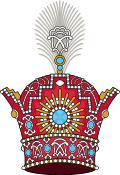
Back Yabğu Azerbaijani یابقو AZB Ябгу Bulgarian Yabghu Catalan Yabghu Spanish یبغو Persian Yabgu French Jabgu Hungarian Yabgu Italian ヤブグ Japanese
| Part of a series on |
| Imperial, royal, noble, gentry and chivalric ranks in West, Central, South Asia and North Africa |
|---|
 |
Yabghu (Old Turkic: 𐰖𐰉𐰍𐰆, romanized: yabɣu,[1] simplified Chinese: 叶护; traditional Chinese: 葉護; pinyin: Yèhù), also rendered as Jabgu, Djabgu or Yabgu, was a state office in the early Turkic states, roughly equivalent to viceroy. The title carried autonomy in different degrees, and its links with the central authority of Khagan varied from economical and political subordination to superficial political deference. The title had also been borne by Turkic princes in the upper Oxus region in post-Hephthalite times.[2]
The position of Yabgu was traditionally given to the second highest member of a ruling clan (Ashina), with the first member being the Kagan himself. Frequently, Yabgu was a younger brother of the ruling Kagan, or a representative of the next generation, called Shad (blood prince). Mahmud Kashgari defined the title Yabgu as "position two steps below Kagan", listing heir apparent Shad a step above Yabgu.[3]
As the Khaganate decentralized, the Yabgu gained more autonomous power within the suzerainty, and historical records name a number of independent states with "Yabgu" being the title of the supreme ruler. One prominent example was the Oguz Yabgu state in Middle Asia, which was formed after the fragmentation of the Second Türkic Kaganate in the 740s. Another prominent example was the Karluk Yabghu, the head of the Karluks which in the 766 occupied Suyab in the Jeti-su area, and eventually grew into a powerful Karakhanid state.[4]
- ^ Entry "𐰖𐰉𐰍𐰆 [yabγu йабғұ"] in "Ethno-Cultural Dictionary" Türik Bitig
- ^ Encyclopaedia Iranica, 2007, p. 316
- ^ Golden P.B., "Khazar studies", Budapest, Vol. 2, 1980, pp. 188–190, ISBN 963-05-1548-2
- ^ W. Barthold, "Four Studies In History Of Central Asia", Leiden, E. J. Brill, 1962, Vol.1 p. 87